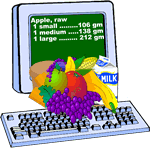This page has been archived and is being provided for reference purposes only. The page is no longer being updated, and therefore, links on the page may be invalid.
|
|
"What's in the Foods You Eat" Now on Home Computers
By Rosalie Marion Bliss
October 24, 2005
Agricultural Research Service (ARS) scientists today launched a free, computer-download version of a searchable nutrient database of typically consumed foods. This consumer-friendly, new resource, "What's In The Foods You Eat—Search Tool," provides a 61-nutrient profile on thousands of the foods people report eating, year in and year out.
The ARS Food Surveys Research Group (FSRG) rolled out the new PC-download product today during the American Dietetic Association's annual conference in St. Louis, Mo. ARS is the U.S. Department of Agriculture's chief scientific research agency. FSRG is headed by supervisory nutritionist Alanna Moshfegh.
|
|
The unique product provides the same food nutrient profiles used to produce FSRG's recent nationwide dietary interview results, entitled "What We Eat in America." The data are provided in commonly consumed portion sizes and weights, and easy-to-use help screens are readily available.
The nutrient profile database made available today is a derivative of the National Nutrient Database for Standard Reference 16-1, a product of the ARS Nutrient Data Laboratory. Both groups are part of the ARS Beltsville (Md.) Human Nutrition Research Center.
FSRG data used in the search tool are also used in USDA's MyPyramid Tracker—a highly interactive, free Internet service that provides a customized nutritional "audit" to individuals who key in foods eaten daily. The search tool provides further support to MyPyramid Tracker users who wish to view the 61-nutrient profile for the same individual foods they key in under their personal profiles. For example, if the tracker shows cholesterol intakes are too high, the user could then go to the search tool, key in the same foods entered, and find out which foods need curbing.
The search tool downloads in minutes over a broadband Internet connection. It will run on computers using the Windows 2000 or XP operating system and requires about 75 megabytes of available disk space. You can download the search tool at www.ars.usda.gov/foodsearch/.


